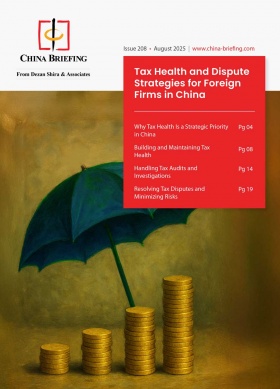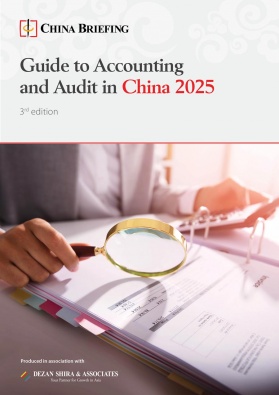China’s Tax Overhaul Ends Third-Party Export Loophole—Are You Ready?
China’s 2025 new tax filing rules are set to transform export compliance by ending the long-standing practice of “export through buying third-party export documents” and enforcing real-name tax reporting. This article explores how STA Announcement No.17 will impact exporters, cross-border e-commerce sellers, logistics providers, and overseas buyers—and what businesses must do to stay compliant.
On July 7, 2025, the State Administration of Taxation (STA) issued the Announcement on Optimizing Matters Related to the Declaration of Corporate Income Tax Prepayment (STA Announcement [2025] No.17). The new regulation, set to take effect on October 1, 2025, introduces a series of adjustments to corporate income tax (CIT) prepayment procedures. Among its most impactful provisions is a significant tightening of tax compliance requirements for export enterprises.
The announcement mandates a clear distinction between self-operated exports and entrusted exports, aiming to eliminate the long-standing practice of “export through buying third-party export documents”—a workaround where companies without export qualifications use third-party documents to declare goods at customs. This move marks the official end of a widely accepted industry loophole and ushers in a new era of penetrative, real-name tax supervision in China’s cross-border trade.
The implications are far-reaching. Many overseas buyers who import from China have already been informed by Chinese export agents and customs brokers that the traditional trading model involving third-party export documents will no longer be viable. This shift not only affects domestic exporters and logistics providers but also reshapes the compliance landscape for global supply chain partners.
In this article, we examine the key provisions of STA Announcement [2025] No.17, analyze its impact on various stakeholders—including cross-border e-commerce sellers, freight forwarders, and overseas buyers—and explore compliant export models that businesses can adopt to navigate the new regulatory environment.
What is “export through buying third-party export documents”—and why regulate it?
The practice of “export through buying third-party export documents” has long been a workaround used by small and medium-sized enterprises (SMEs) and factories that lack their own import-export licenses or customs clearance capabilities. Under this arrangement, a manufacturer hires a third-party export agent—typically a trading company or logistics provider—to export goods using the agent’s credentials. In essence, the manufacturer pays a fee to “borrow” the agent’s export license, allowing the goods to be shipped under the agent’s name.
While this model may appear to be a practical solution for businesses facing regulatory or operational constraints, it operates in a legal gray zone. Its compliance status depends heavily on execution details, and in many cases, it leads to serious regulatory violations:
- Mismatch between declared and actual exporter: Under China’s Foreign Trade Law, entities engaging in import and export activities must be officially registered. In the “export through buying third-party export documents” model, the declared exporter (the agent) is not the actual cargo owner (the manufacturer). This misrepresentation violates the Customs Law, which requires truthful declarations. It also undermines customs supervision, making it difficult for authorities to trace the real source of goods.
- Tax evasion: In many cases, the agent—who appears as the exporter on customs documents—does not treat the export income as part of its own taxable revenue. Meanwhile, the actual manufacturer, whose name does not appear in customs records, also fails to declare the income. This results in undeclared revenue, exposing both parties to CIT risks and potential penalties for concealing taxable income.
- Foreign exchange violations: Exports must be accompanied by corresponding foreign exchange receipts. In this model, payments from overseas buyers often go directly to the manufacturer’s account—sometimes offshore—while the declared exporter shows no matching foreign exchange income. This creates a disconnect between customs declarations and foreign exchange flows, violating China’s foreign exchange control regulations and potentially triggering investigations into illegal capital inflows or currency evasion.
More critically, it obstructed regulatory transparency. Customs declarations often listed shell companies as the “domestic consignor” or “production unit,” many of which were later deregistered or dissolved. This made it nearly impossible for tax, customs, and foreign exchange authorities to trace the real cargo owner or verify the legitimacy of transactions.
In recent years, several major tax fraud cases have exploited this loophole. For instance, in a 2023 case, a shell company involved in “selling export documents” was found to have falsified export data and input value-added tax (VAT) invoices. As a result, it was barred from claiming export tax rebates for two years, highlighting the severe consequences of non-compliance.
What has changed under STA Announcement [2025] No.17?
STA Announcement No.17 introduces a series of targeted reforms to the tax declaration process for export enterprises. These changes are designed to enhance transparency, clarify tax responsibilities, and eliminate non-compliant practices. The announcement provides detailed guidance on how different export models—self-operated, entrusted, and agent-based exports—should be treated for corporate income tax purposes.
Income classification and declaration requirements
Article 6 of the announcement introduces clear distinctions in how export income should be classified and reported:
- Self-operated exports: Enterprises must include export revenue under “business income” and separately report it as “self-operated export income” in the tax declaration forms.
- Entrusted exports: The entrusting party (that is, the actual producer or seller) must declare the full export income. The agent (that is, the trading company or logistics provider) only reports service fees as income.
This distinction ensures that tax obligations align with the actual flow of goods and revenue, closing loopholes that previously allowed income to go undeclared.
Article 6 Production and sales enterprises exporting goods shall calculate and declare enterprise income tax according to law on the income obtained from their exported goods. Among them, enterprises exporting goods through self-operated methods shall declare the income corresponding to the goods produced and sold by the enterprise itself; enterprises exporting goods through entrusted methods shall declare the income corresponding to the goods entrusted for export by the enterprise.
Compliance obligations for agent exporters
Agent exporters—including those operating under market procurement trade (1039) or foreign trade comprehensive service platforms—now face stricter reporting duties:
- During the prepayment declaration, agents must submit a transaction-level summary table (《代理出口企业受托出口情况汇总表》), disclosing:
- The name of the actual entrusted exporter
- Their Unified Social Credit Code (USCC)
- The export amount and declaration number
- If the agent fails to accurately report this information—or lists a non-actual exporter such as a freight forwarder or non-resident entity—the transaction will be reclassified as a self-operated export, and the agent will be liable for CIT on the full export value.
This provision effectively eliminates the “don’t ask, don’t tell” approach previously tolerated by some freight forwarders and logistics firms.
Article 7 Enterprises acting as agents, including those exporting goods through methods such as market procurement trade and foreign trade comprehensive services, shall simultaneously report basic information of the actual entrusted exporter and the export amount during the pre-payment declaration. If an enterprise fails to accurately report the basic information of the actual entrusted exporter and the export amount, it shall be treated as a self-operated method, and the enterprise shall bear the corporate income tax payable on the corresponding export amount. The actual entrusted exporter refers to the actual production and sales unit of the exported goods.
Typical case scenarios: How the new rules apply in practice
To illustrate how STA Announcement [2025] No.17 will be enforced, the following examples demonstrate the tax treatment of different export arrangements under the new compliance framework:
Case 1: Standard entrusted export
Scenario:
- A Company acts as an export agent for B Company, a domestic manufacturer.
- Export value: RMB 10,000,000
- Agency fee: RMB 100,000
Tax treatment:
- A Company must declare RMB 100,000 as agency service income and submit a detailed report disclosing B Company’s name, Unified Social Credit Code (USCC), and export amount.
- B Company, as the actual producer and seller, must declare the full RMB 10,000,000 as entrusted export income and fulfill its corporate income tax obligations accordingly.
Compliance note:
This is a compliant entrusted export model. Both parties fulfill their respective tax responsibilities, and the export rebate (if applicable) can be processed based on the real transaction chain.
Case 2: Multi-layered agency chain
Scenario:
- C Company acts as an agent for D Company, which in turn is acting on behalf of E Company, the actual domestic manufacturer.
- Export value: RMB 10,000,000
Tax treatment:
- Under Announcement No.17, C Company must directly disclose the information of E Company, the actual entrusted exporter.
- If C Company instead reports D Company or a freight forwarder as the entrusted party, the transaction will be reclassified as a self-operated export, and C Company will be liable for corporate income tax on the full RMB 10,000,000.
Compliance note:
The regulation pierces through intermediary layers to identify the true cargo owner. Any failure to report on the actual production and sales entity will result in full tax liability shifting to the agent, regardless of their role in the transaction chain.
Impact on business stakeholders and how to prepare
The rollout of STA Announcement [2025] No.17 introduces a new era of real-name, data-driven tax supervision in China’s export sector. These policies are reshaping how businesses manage export operations, compliance, and partnerships—particularly for cross-border e-commerce sellers, logistics providers, and overseas buyers.
Export enterprise
For export enterprises, the most immediate impact is the potential lengthening of export tax rebate cycles. With stricter documentation requirements and real-name reporting, companies must now ensure that their invoice records, customs declarations, and foreign exchange receipts are fully aligned. This calls for a significant upgrade in internal systems and processes, especially in managing the flow of goods, documents, and funds.
The traditional “export through buying third-party export documents” model—where manufacturers without export qualifications relied on third-party agents to declare goods—is now effectively blocked. Enterprises must transition to compliant export structures, either through self-operated exports or properly documented entrusted arrangements.
For manufacturers and production-based exporters, this means building a robust customs and tax compliance framework, ensuring consistency across accounting books, customs filings, and payment records. When working with freight forwarders or logistics companies, businesses must audit their qualifications and clearly define declaration responsibilities in contracts to avoid being held liable for agent misconduct.
Cross-border e-commerce sellers
Cross-border e-commerce sellers face a particularly complex challenge. Many rely on logistics intermediaries such as YunExpress or Yanwen to handle export declarations. Following the policy announcement, some intermediaries have already stopped accepting shipments from individual sellers, citing compliance risks. Sellers using models like “overseas warehouse + B2B2C” must now pay close attention to the timing of foreign exchange receipts and ensure that these match their export declarations to remain eligible for tax rebates. With STA Announcement [2025] No.15 requiring platforms to report seller income, orders, and commissions, the sector is entering a phase of high transparency and strict oversight, where income, cost, and profit data will be subject to full regulatory scrutiny.
Freight forwarders and logistics companies
Freight forwarders and logistics companies are also under pressure. The previous “don’t ask, don’t tell” approach—where agents turned a blind eye to the true identity of the cargo owner—is no longer viable. These companies must now verify and disclose the actual exporter’s information. Failure to do so may result in the agent being classified as the exporter and taxed on the full export value. To mitigate risk, logistics firms must restructure their business models, clearly separate agency fees from export income, and ensure accurate reporting.
Import-export enterprises
Import-export enterprises must exercise greater caution when sharing export credentials with third parties. It is essential to sign formal agreements that require partners to disclose the real cargo owner. If a company discovers that its name has been misused in customs declarations, it should proactively report the situation to customs or tax authorities to seek lenient treatment.
Overseas buyers
Overseas buyers are not immune to these changes. Many purchase goods from Chinese factories that previously relied on non-compliant export methods. With the new regulations in place, some customs brokers and logistics firms have stopped offering such services, while others have significantly increased fees to offset tax risks. In some cases, overseas buyers are now required to provide detailed information about the actual Chinese exporter.
To adapt, overseas buyers have several options. They can work with Chinese suppliers to export goods under the supplier’s name using compliant methods. Alternatively, they can engage a third-party export agent, ensuring that the supplier is listed as the entrusting party. For larger buyers, establishing a local entity in China may be a strategic move—allowing them to purchase goods and export directly under their own name.
- Previous Article A Guide to Minimum Wages in China (As of September 17, 2025)
- Next Article How Did Dior Violate China’s Personal Information Protection Law? Lessons from the PIPL Probe







